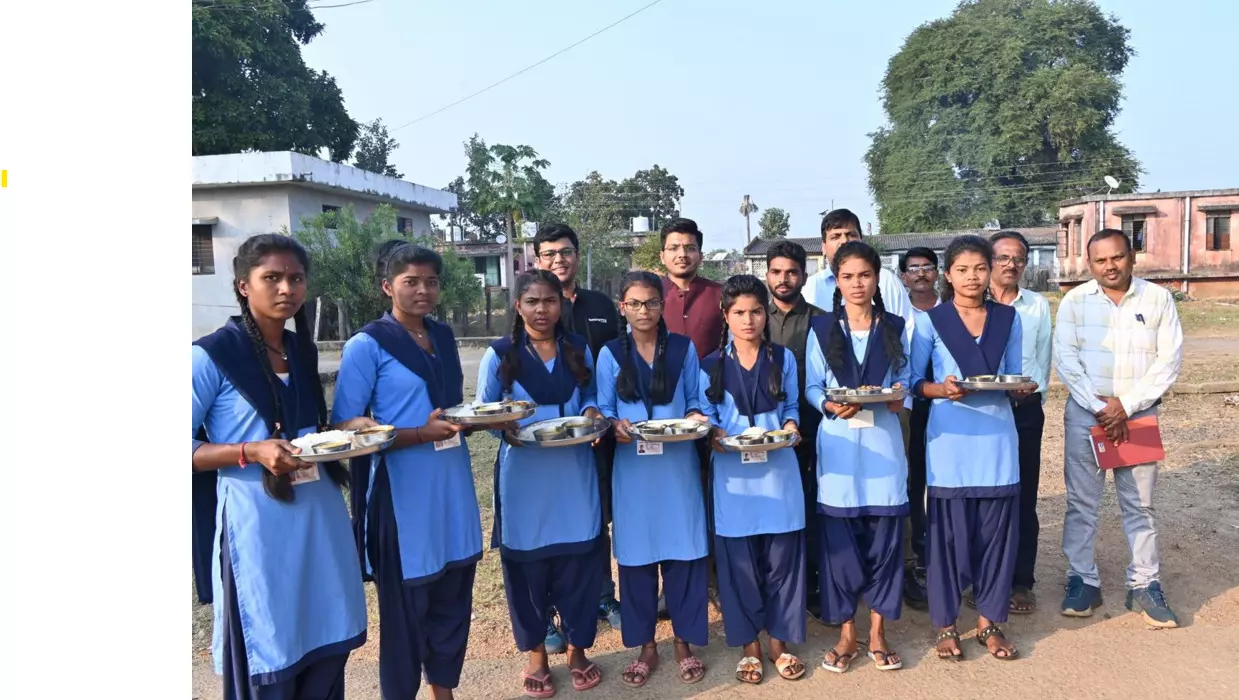AI-based augmentation
With the use of AI-based nutrition tracking, an IAS officer in Maharashtra’s Gadchiroli district has managed to address malnutrition among tribal students by fixing the loopholes in implementation of PM-POSHAN scheme

Young school-going children are provided with mid-day meals under the annual Rs 11,600 crore scheme (PM-POSHAN) run by the Government of India, with an almost equal contribution by the states. As is evident, not only is a substantial amount spent under the scheme, but it also impacts the nutritional health of the children. This, in turn, affects their education. Assessing the quality of the food is an issue that was addressed in a Naxal-affected district, Gadchiroli, Maharashtra, by a young IAS officer, Shubham Gupta, who had just entered the service. It has been implemented as a pilot to trace the nutritional parameters of meals served to students of a government Aashram School in Todsa village of the Etapalli block of the district.
It all began with one of Shubham’s routine visits to the school. Usually, the visit wasn’t during the students' lunch, but this time it happened so. On keenly observing the students, Shubham realised that many of them were visibly malnourished. He was confused. Normally, this would be attributed to a lack of funding, poor quality of grains, or improperly cooked food, but at least funding was not an issue in this school, which is run by the Tribal Development Department of the Government of Maharashtra. He wanted to delve deeper into the problem. The BMI of all 222 students was checked. Sadly, his apprehensions were confirmed, with 61 out of the 222 students being identified as malnourished.
On thinking through the problem, he realised that a technological solution would be more accurate and durable. He contacted a non-profit organisation, Feeding India by Zomato, which, in turn, put him in touch with a start-up called Udyog Yantra. Udyog Yantra was already working on a similar problem statement with some additional utilities. A decision was made to partner and implement this as a pilot in the same school. The funding for the pilot was provided by Feeding India itself.
A beginning was made with installing the Udyog Yantra machine in the school, providing and training an independent human resource to onboard all the students onto the machine. Efforts were also made to train the AI-based algorithm with local data for accurate image recognition, address the initial glitches, and finally handhold the school superintendent to eventually hand over the project to them. Interestingly, the human resource, an unemployed but smart tribal boy, ended up working full-time for Udyog Yantra and moved to Delhi with his whole family, marking his first time out of Gadchiroli.
The utilities of the project were:
✼ Checking for pilferage (actual number of meals being served vs registered students)
✼ Menu compliance (are the students getting all the items as per prescribed menu?)
✼ Nutrition tracking (proteins, calories, carbohydrates, etc. that each student is getting every day)
✼ BMI tracking (underweight, normal, overweight and obese)
✼ Nutrition and Health Report Card of each student
✼ Nutrition vs BMI correlation (to do targeted nutrition delivery)
✼ Monitoring quality of meals
All the data from each scan was then accumulated and classified in the form of a dashboard with access only to the Headmaster, Assistant Project Officer, and Shubham. This dashboard had student-wise and class-wise data based on the above seven indicators, which could be further filtered and categorised as needed.
Being an area less exposed to technology, it was initially a challenging task to convince and explain the utility of the project to the stakeholders involved. The funding by Feeding India made the job easier. Shubham had to personally explain to the Assistant Project Officer, Headmaster, and Superintendent the need for the project and assure them of no penalties in case of any adverse conclusions. It still required regular follow-up on a daily basis to ensure its proper implementation.
The first month of implementation drew the following conclusions as reasons for the malnourishment of the students:
✼ Lack of menu compliance (repeated or missing items in the menu)
✼ Poor quality of certain food items such as eggs and bananas
✼ Serving of less warm or cold food to the students, leading to reduced nutrition
✼ Irregularity in student attendance (missing school or missing meals)
✼ Average quality of cooked food, especially items such as dal and daily vegetables
These findings were mentioned to the Headmaster, Superintendent, and other stakeholders in the monthly review meetings, which, on their own, resulted in improvement on all counts. This happened primarily because someone had access to objective data and could monitor them through the help of this AI-based algorithm. Slowly, things started to improve, and more than two-thirds of the students who were previously malnourished were brought to the normal category without any additional dietary intervention, but only through plugging the loopholes with regular monitoring and objective data collection.
Technology has the potential to transform governance in many spheres. Shubham illustrates that through this pilot project. What has been successfully demonstrated in a school presents a wonderful example of the Nexus of Good as it can be replicated in all the government and semi-government schools availing the benefit of the PM-POSHAN scheme run by the Government of India. With more advanced technology, the machine can be compacted into a mobile application for monitoring the quality of meals being served to students in such schools and tracking the nutritional parameters of the students for timely intervention. This can be a long-impending and revolutionary step in the overall ambit of streamlining this ambitious scheme of the government.
Views expressed are personal



